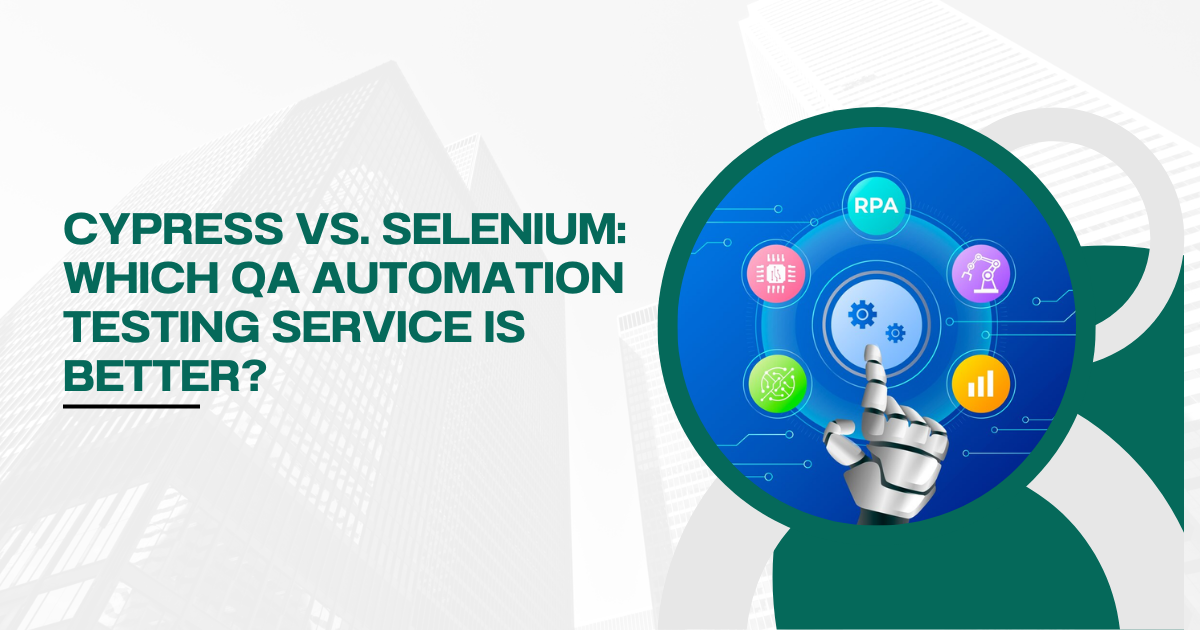Cypress vs. Selenium: Which QA Automation Testing Service is Better?

Strong 8k brings an ultra-HD IPTV experience to your living room and your pocket.
In the world of Quality Assurance (QA) and software testing, automation has become a critical component of the development lifecycle. Automated testing tools help ensure that applications are free of bugs and function correctly, without the need for repetitive manual testing. Two of the most widely used tools in the market today are Cypress QA Automation Testing and Selenium. Both offer unique features that cater to different testing needs, but choosing the right tool can be a challenge for many development teams.
What is Cypress QA Automation Testing?
Cypress is a modern and open-source end-to-end testing framework designed for web applications. It is built specifically for the developers and QA engineers who are looking for fast, reliable, and easy-to-use testing solutions. Cypress offers both unit and integration testing, but it shines particularly in end-to-end testing.
Cypress has the ability to run tests inside the browser itself, which gives it better control over the tests and ensures faster execution. It also provides real-time feedback, instant reloading, and easy debugging, which can be particularly useful for developers looking to write robust test cases efficiently.
Key Features of Cypress QA Automation Testing:
Fast Execution: Cypress runs tests directly in the browser, making it faster than traditional testing frameworks.
Real-Time Reloading: As developers write tests, Cypress instantly reloads, providing real-time feedback.
Debugging Support: Cypress provides a powerful debugging environment with detailed error logs and stack traces.
Automatic Waits: Cypress automatically waits for elements to load before interacting with them, reducing the need for manual waits in tests.
Cross-Browser Testing: While originally limited to Chrome, Cypress now supports testing on multiple browsers, including Firefox and Edge.
What is Selenium?
Selenium is one of the most popular and widely used open-source frameworks for automating web browsers. It supports multiple programming languages, such as Java, Python, C#, and Ruby, allowing developers to write test scripts in the language they are most comfortable with. Selenium is a powerful tool for automating tests across a variety of browsers, making it a highly versatile option for QA teams.
Selenium consists of multiple components, including Selenium WebDriver, which is the core component for controlling web browsers, and Selenium Grid, which allows running tests on multiple machines simultaneously.
Key Features of Selenium:
Cross-Browser Testing: Selenium supports almost all major browsers, including Chrome, Firefox, Safari, and Internet Explorer.
Language Flexibility: Selenium supports a wide range of programming languages, giving developers flexibility in choosing the language for writing test scripts.
Distributed Testing: Selenium Grid allows users to execute tests across different machines, environments, and browsers.
Large Ecosystem: Selenium has a vast ecosystem of plugins, integrations, and tools for additional functionality.
Comparison Between Cypress and Selenium
Let’s now break down the differences between Cypress QA Automation Testing Services and Selenium based on key parameters that affect testing performance and experience.
1. Installation and Setup
Cypress
Setting up Cypress QA Automation Testing is straightforward. It comes with a simple installation process through npm (Node Package Manager) and doesn’t require any complex configuration. Since Cypress operates directly in the browser, developers don’t need to install browser drivers or other dependencies.
Selenium
Selenium requires more setup steps compared to Cypress. You need to install the WebDriver for the specific browser you intend to test on, and you may also need to set up additional tools for managing dependencies and configurations. While Selenium supports multiple languages, it requires the setup of corresponding drivers for each language and browser, which can be time-consuming.
2. Performance and Speed
Cypress
Cypress is known for its high performance and speed. Tests run within the browser itself, making the testing process faster than traditional tools like Selenium. Cypress automatically waits for elements to load, eliminating the need for manual sleep or wait times, which contributes to faster execution.
Selenium
Selenium can be slower than Cypress because it runs tests outside the browser and interacts with the browser using the WebDriver API. This means Selenium requires more time to communicate with the browser and wait for elements to load, which can slow down test execution, especially in large-scale applications.
3. Cross-Browser Testing
Cypress
Although Cypress has made significant progress in supporting multiple browsers, its cross-browser support is still limited compared to Selenium. As of now, Cypress supports only Chrome, Firefox, and Edge. This means you may face challenges when needing to test on browsers like Safari or Internet Explorer.
Selenium
Selenium excels in cross-browser testing. It supports all major browsers, including Chrome, Firefox, Safari, Internet Explorer, and even mobile browsers. This makes Selenium a better option for teams that need to test their applications across a variety of browser configurations.
4. Test Stability and Reliability
Cypress
Cypress tests are more stable than Selenium because they run directly in the browser. Since Cypress is aware of the application’s state at any given time, it can automatically handle certain elements and wait for them to load before interacting with them. This reduces the likelihood of flaky tests and improves overall reliability.
Selenium
Selenium is more prone to flaky tests because it works with a separate WebDriver to control the browser. As a result, it may experience issues with synchronization, where tests may attempt to interact with elements before they are fully loaded. This can lead to test failures that require additional time to debug.
5. Debugging and Error Handling
Cypress
One of the standout features of Cypress QA Automation Testing Services is its built-in debugging capabilities. Cypress provides a rich set of debugging tools, such as real-time browser interaction, time travel (viewing previous states), and detailed error logs. The ability to debug directly within the browser makes it easier for developers to pinpoint issues quickly.
Selenium
Selenium offers basic debugging tools, such as logs and stack traces, but it doesn’t have the real-time debugging features of Cypress. While Selenium supports integrations with other debugging tools, developers often find it more challenging to troubleshoot issues with Selenium compared to Cypress.
6. Learning Curve and Community Support
Cypress
Cypress has a relatively shallow learning curve, especially for developers familiar with JavaScript. Its syntax is simple and intuitive, and its documentation is comprehensive, making it easy for beginners to get started. Additionally, Cypress has a growing community that actively contributes tutorials, forums, and solutions to common problems.
Selenium
Selenium has a steeper learning curve, especially for newcomers. Since it supports multiple programming languages, developers must choose a language and become familiar with its corresponding WebDriver bindings. However, Selenium has been around for a long time and has a large, well-established community, providing a wealth of resources and support.
7. Integration with CI/CD Tools
Cypress
Cypress integrates seamlessly with modern Continuous Integration (CI) and Continuous Delivery (CD) tools like Jenkins, Travis CI, and CircleCI. The integration process is simple, and Cypress provides built-in support for headless testing, which is essential for CI/CD pipelines.
Selenium
Selenium also integrates well with CI/CD tools and is commonly used in automated testing pipelines. However, the setup process for Selenium might be more complex due to its dependency on external drivers and configuration files.
8. Pricing
Both Cypress and Selenium are open-source tools, meaning they are free to use. However, organizations may incur costs related to infrastructure, training, or consulting if they require assistance in setting up or maintaining the testing environment.
When to Choose Cypress QA Automation Testing Services?
Web-Application Focused Projects: If your project primarily focuses on web applications and you need a fast, easy-to-use tool that supports JavaScript, Cypress is an excellent choice.
Modern Web Technologies: Cypress is perfect for modern web applications that utilize frameworks such as React, Angular, or Vue.js, as it was specifically built to work with these technologies.
Speed and Debugging: For teams that need quick feedback and efficient debugging, Cypress provides an edge due to its fast test execution and built-in debugging tools.
When to Choose Selenium?
Cross-Browser Testing: If your testing needs require extensive cross-browser support, Selenium is the best choice due to its wide compatibility with different browsers.
Multiple Language Support: Selenium is ideal for teams working with different programming languages. It supports Java, Python, C#, and Ruby, offering flexibility for developers.
Complex Web Applications: For large-scale web applications that require intricate test scripts, Selenium provides the flexibility to handle complex scenarios.
Conclusion
Both Cypress QA Automation Testing and Selenium are powerful tools, but the right choice depends on your specific requirements. If you’re working with modern web applications, need fast execution, and require seamless debugging, Cypress offers a more efficient and user-friendly experience. However, if you require broader browser compatibility, language flexibility, and distributed testing capabilities, Selenium remains the more versatile tool.
Ultimately, the decision to choose Cypress QA Automation Testing Services or Selenium will depend on your team's needs, expertise, and the scope of the project. By understanding the key differences and features of both tools, you can make an informed decision that optimizes your automated testing efforts.
Note: IndiBlogHub features both user-submitted and editorial content. We do not verify third-party contributions. Read our Disclaimer and Privacy Policyfor details.







